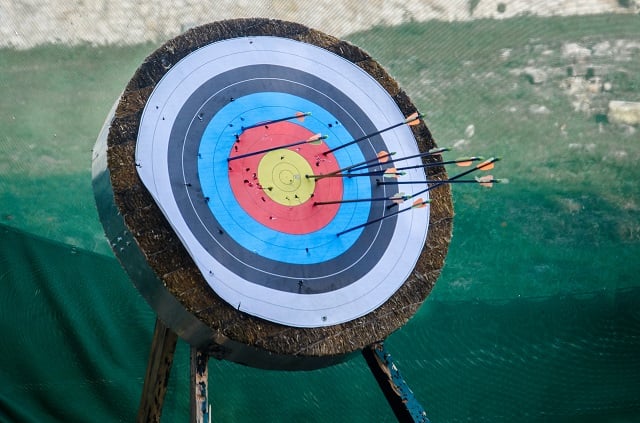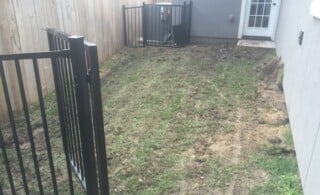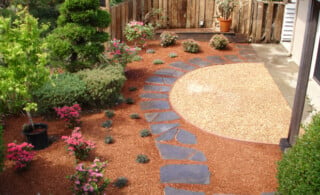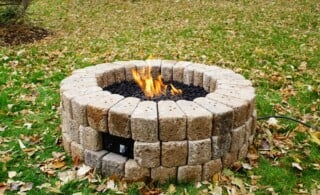
Unlike putting greens, hockey rinks, and soccer fields, building a backyard archery range doesn’t require extensive amounts of time, money, or do-it-yourself expertise. There are only a few pieces of equipment to buy or make as well as a few key concerns to address. However, just because the process isn’t as complicated doesn’t mean careful planning, preparation, and setup aren’t required. Like with any backyard sports arena, those are the keys to a safe, legal, enjoyable experience.
Planning and Prep
Before you turn your backyard into a scene from Robin Hood or The Hunger Games, there are a few steps you’ll need to take to ensure your planned archery range is legal, safe, and budget-friendly.
Legal Concerns
Depending on where you live, it may not be legal to practice with your bow and arrow at home. Whether you live within the city limits, public ordinances, permit laws, and proximity to neighboring properties and structures can all factor into the legality of practicing your craft in your backyard. In some cases, you may even need a local government representativeto inspect and approve your setup before you receiving permission. Save yourself some trouble — both literally and figuratively — by contacting your local police department or sheriff’s office first.
Safety Concerns
In addition to the legality of a backyard archery range, there are plenty of safety concerns to consider when it comes to shooting a dangerous weapon near your home and family. Even the most experienced and skilled archers have accidentally fired an arrow somewhere it wasn’t intended to go. A rogue arrow could easily be a threat to humans, animals, and property alike.
There are a few hard and fast rules when it comes to backyard archery safety.
- First of all, never sky-draw your bow. Keep your bow pointed level at the target or lowered toward the ground at all times.
- You should also always inform your neighbors that you practice in your yard. This will give you a chance to let them know it is legal and that you are taking the proper precautions to ensure their safety.
- Finally, you should scout the area surrounding your target so that you know what structures, public spaces, livestock, and other features exist within 400 yards in every direction.
Knowing these rules can help you determine where you place your target and ensure you build in ample protection around it. You’ll also be informed to operate, both consciously and subconsciously, with others’ best interest in mind. For example, you may choose to place your target at the edge of your property facing a wooded area, or you may refrain from shooting on Thursday evenings when your neighbor’s grandkids come over for dinner and often play in the backyard. Furthermore, every time you draw the arrow, you’ll do so carefully so you won’t cause injury or damage.
Budget Concerns
Like with any home project, it’s important to map out your costs before you start your project so you know what to expect. While you probably won’t need to grading company in your area to level your property or find a general contractor near you to manage the project, there may be some instances where you need to get a quote and factor in labor and materials. For instance, you may need to call a local handyman to help you build a frame for your backstop netting. If you don’t already have one, you may also need to budget the cost to install a privacy fence around your range area or your entire property, especially if you live in a suburban neighborhood.
In addition to any costs associated with preparing your yard, you’ll also need to budget for materials and equipment for the range setup. Options vary in price from budget-friendly to top-of-the-line. For more on this, keep reading.
The Setup
Every backyard archery range needs two things: a backstop and a target. Aside from that, how you design and equip your setup is an individual choice. Do you want a professional-grade archery range, or will a target tacked to some bails of hay work for you? No matter what look or functionality you are going for, options abound in every style and price range.
The Backstop
The ultimate goal of a backstop is to prevent arrows from traveling past the target and piercing other objects, so function is more important than form. Plenty of low-budget, low-tech options are available that can effectively do that. Here are a few options in that category:
- Hay bale: Layer hay bales three or four high and at least two deep to ensure arrows don’t penetrate through. Fluff bails directly around the target regularly, and fill holes to prevent soft spots.
- Pile of dirt: Giant piles of dirt may not be attractive, but they are effective. If you’ve had excavating done, you may already have a pile of dirt near the edge of your property. If you have the space, you can also buy a load of fill dirt for between $150 and $350 per truckload.
- Trees: While a good-sized tree can stop an arrow, it is only effective as a backstop if you surround it with additional materials. Otherwise, there isn’t enough clearance around your target for safety. In other words, you will need a back-up backstop.
If you are looking for something more professional, you have plenty of choices. Whether you DIY these fancier options or buy them off the shelf, they will cost you more. However, they will blend more seamlessly into your landscape, making them well worth the price.
- Framed backstop: For a custom look, build your own frame out of lumber and attach a sheet of plywood to the front. Then, cover the plywood with a sheet of foam, like the ones they use in cow stalls or on gym floors. You can customize the size, shape, and color. You can even build a roof on the structure to protect your target, or you can make it mobile by adding casters to the legs.
- Netting: Specialty archery netting is available online for between $75 and $750, depending on the size you require. You’ll need a way to hang the fabric, so you’ll probably still want to purchase or build a frame.
- Fence panel: Ready-made, wooden fence panels cost between $35 and $100 from home improvement stores. To keep the panel upright, attach them to in-ground posts, or build cantilever legs. In most cases, you’ll also need to apply a finish or sealant to protect the wood from the weather. To protect your neighbors — and your arrows — be sure to cover the panel with foam or another material that will absorb the impact and prevent penetration.
The Target
When choosing a target, it’s a matter almost entirely of personal preference when it comes to shooting style, appearance, and longevity. Some of the most common options are as follows:
- Bag targets: Low-cost bag targets are dual-sided and lightweight, and your arrows will be easy to remove. While the bags are easy to use and move around, they are less durable and don’t last as long as other options.
- Foam blocks; Heavy-duty foam block targets provide six shooting faces and longevity. However, their size and bulk can make them more difficult to manipulate. They are also more expensive than bag targets.
- DIY carpet targets: If you can get your hands on several dozen carpet remnants, you can make one of the longest-lasting, most cost-effective targets out there. Simply compress the targets vertically, using a plywood frame.
- Sheet targets: Sheet targets, that you can tack to cardboard bales, offer a variety of target styles to keep it fun. Game faces, like tic-tac-toe and baseball, can help prevent burnout on traditional targets.
A note about accessibility
Archery is a sport that everyone can enjoy, especially people with disabilities. Therefore, it makes sense to ensure your backyard range is accessible to people with mobility and vision impairments. Cultivating a disability-friendly outdoor space means ensuring the ground is level, pathways are wheelchair accessible, well lit, and clear of debris. Place targets at the appropriate height for your practice.
Archery enthusiasts don’t need a lot of time, money, or outdoor space to create an area to practice their beloved hobby. With a few simple materials (and permission from your neighbors), you can hit the bullseye on this at-home project.
 Spring Garden Flower Tips and Suggestions
Spring Garden Flower Tips and Suggestions  Plan Ahead for a Better Yard
Plan Ahead for a Better Yard  Dry Well Cleaning & Maintenance Tips
Dry Well Cleaning & Maintenance Tips  Soil Engineers & Testing
Soil Engineers & Testing  How To: Build A Gas Fire Pit in 10 Steps
How To: Build A Gas Fire Pit in 10 Steps 

Are You Familiar With This Topic? Share Your Experience.